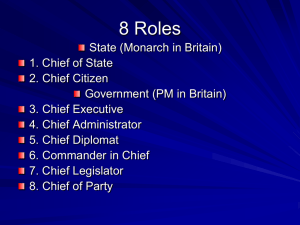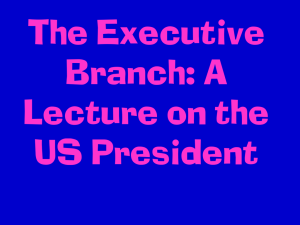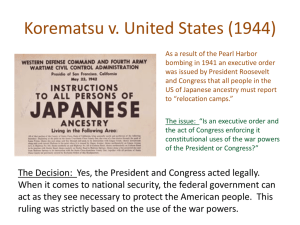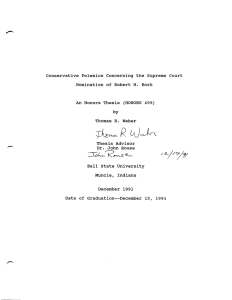President's Informal Powers and Checks on the President Worksheet
advertisement
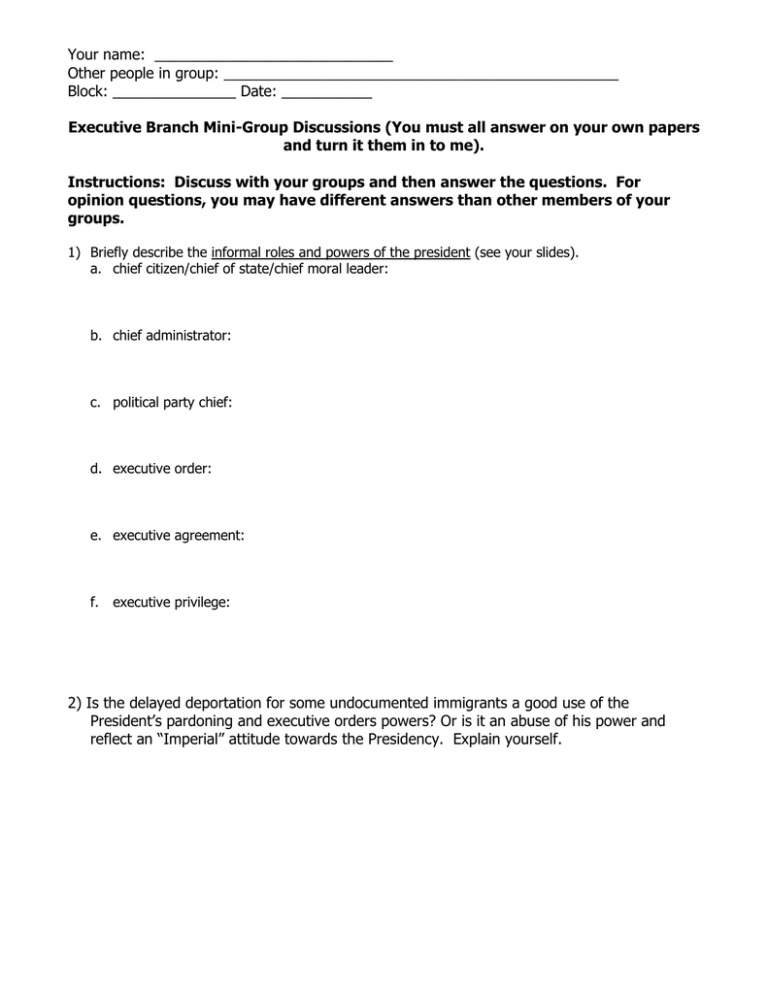
Your name: _____________________________ Other people in group: ________________________________________________ Block: _______________ Date: ___________ Executive Branch Mini-Group Discussions (You must all answer on your own papers and turn it them in to me). Instructions: Discuss with your groups and then answer the questions. For opinion questions, you may have different answers than other members of your groups. 1) Briefly describe the informal roles and powers of the president (see your slides). a. chief citizen/chief of state/chief moral leader: b. chief administrator: c. political party chief: d. executive order: e. executive agreement: f. executive privilege: 2) Is the delayed deportation for some undocumented immigrants a good use of the President’s pardoning and executive orders powers? Or is it an abuse of his power and reflect an “Imperial” attitude towards the Presidency. Explain yourself. The President in Check Directions: In this activity, your group will discuss the examples below, and analyze who and by what means the president’s power is checked. There may be multiple checks involved. Record your answers on the chart provided. 1. In 1987, President Reagan nominated conservative federal appeals judge Robert Bork to the U.S. Supreme Court. A hotly contested Senate debate ensued fueled by strong opposition from civil and women's rights groups worried that Bork would vote to reverse key Supreme Court decisions like Roe v. Wade. TV ads sponsored by pro-choice interest groups like the National Organization for Women, coupled with intense media exposure aided in the failure of Bork’s confirmation in the Senate. 2. In a series of in depth reports, Washington Post reporters Woodward and Bernstein exposed the Nixon White House’s involvement in the Watergate break-in and cover-up. After an intensive bipartisan investigation and hearings, the House Judiciary Committee voted to recommend several articles of impeachment against President Nixon. With support in his own party weakening and public opinion against him, Nixon resigned the presidency on August 9, 1974. 3. With public opinion sagging to a new low following the Tet Offensive, President Johnson announced he would not seek re-election in 1968. 4. Republican leaders in the Senate opposed and successfully thwarted President Wilson’s efforts to gain ratification of the Treaty of Versailles and America’s entrance into the League of Nations after World War I. 5. George Washington established the precedent of serving no more than two terms in office, a tradition broken by FDR when he won his third term in 1940. Concerned that the president could become a “benevolent dictator,” threatening the separation of powers, Congress proposed an amendment in 1947 that would limit the president to 2 terms or 10 years. Presidents Eisenhower, Reagan, Clinton and now George W. Bush have been affected by these term limits. 6. Responding to both separation of powers concerns within the legislature and public discontent with how Presidents Johnson and Nixon prosecuted the war in Vietnam, Congress passed the War Powers Resolution in 1973. The WPR attempted to limit the President’s ability to wage war without the consent of Congress. The House and Senate were able to override President Nixon’s veto by a 2/3 majority. Since its passage in 1973, presidents have reported to Congress 118 instances under the War Powers Resolution. Congress has thus far given its consent to the president 100% of the time. 7. In 1952, the Supreme Court ruled that President Truman did not have the authority to seize steel mines during the Korean War. 8. In 1993, President Clinton proposed a comprehensive health care reform package including universal health care, an effort spearheaded by First Lady, Hillary Clinton. With a Democratic majority in both houses of Congress, passage initially seemed likely. The plan received significant opposition from interest groups (ex: insurance companies, the American Medical Association, National Taxpayers Union), powerful corporations (ex: General Electric, General Motors), and influential members of the Republican party like Newt Gingrich who helped to turn public opinion against the reform. Clinton’s plan ultimately died in Congress. 9. Riding the wave of public opinion to curb federal spending, Congress passed the Line Item Veto Act in 1996 that allowed President Clinton and his successors to “cancel” or “nullify” certain provisions of appropriations bills (meaning certain line specific items, not the whole bill). However, the Supreme Court declared the law unconstitutional because it violated the separation of powers. 10. In 2002, organizations like the Center for Constitutional Rights challenged in court the Bush administration’s policy of detaining those identified as enemy combatants (i.e. those captured in Afghanistan, etc. believed to be members of the Taliban or Al Qaeda) indefinitely without access to a lawyer or a trial. In Rasul v. Bush (2004), the Supreme Court ruled that those held at Guantanamo Bay, Cuba may have access to the U.S. Court system to challenge their detentions. Scenario 1 Bork Nomination 2 Nixon & Watergate 3 LBJ Reelection 4 Wilson & Treaty of Versailles 5 Term Limits 6 War Powers Resolution 7 Truman & Steel Mills 8 Clinton Health Care Reform 9 Line Item Veto 10 GWB & Detainees Who or what group checked the President’s power? Why do you think they did this?

